Notes: Southport Lord Street was the northern terminus of the Southport & Cheshire Lines Extension Railway (SCLER) which was authorised as a route between the Cheshire Lines Committee (CLC) North Liverpool Extension Line at Aintree and Southport’s fashionable Lord Street on 11 August 1881. Although an independent concern the SCLER was backed by the CLC, a joint company made up of the Great Northern Railway (GNR), the Manchester Sheffield & Lincolnshire Railway (MS&LR) and the Midland Railway (MR). By the 1880s Southport had become a popular seaside resort and it was already served by three railways; the Lancashire & Yorkshire Railway (LYR) had lines to Manchester via Wigan and to Liverpool via Crosby and the West Lancashire Railway (WLR) had a line to Preston.
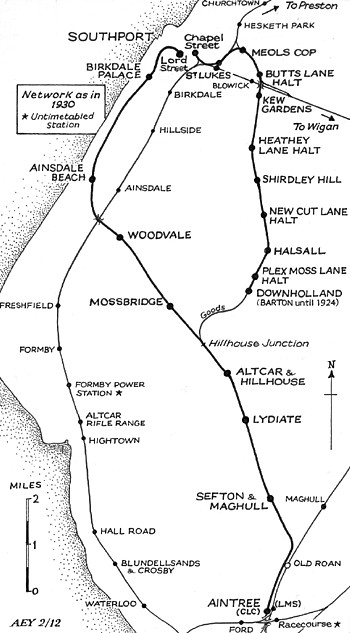 The SCLER opened on 1 September 1884. The company’s Southport terminus was located towards the south end of Lord Street on the south-west side. Lord Street was the main street of Southport, a spacious boulevard developed with shops fronted by elegant glass verandahs, theatres and hotels. Napoleon III lived in the town for five years until 1851. After he returned to France to become Emperor, much of the centre of Paris was laid out with wide tree-lined boulevards – possibly inspired by Southport! The SCLER had a convenient location for their terminus close to the centre of the town. The SCLER opened on 1 September 1884. The company’s Southport terminus was located towards the south end of Lord Street on the south-west side. Lord Street was the main street of Southport, a spacious boulevard developed with shops fronted by elegant glass verandahs, theatres and hotels. Napoleon III lived in the town for five years until 1851. After he returned to France to become Emperor, much of the centre of Paris was laid out with wide tree-lined boulevards – possibly inspired by Southport! The SCLER had a convenient location for their terminus close to the centre of the town.
The station was a grand affair. Fronting on to Lord Street was a red-brick Italianate structure with a tall clock-tower projecting between the glazed verandahs which characterise the street. Biddle (2003) notes that the four-stage tower has stone dressings, round-headed lancet windows, and chamfered corners on the top stage, surmounted by a squat, four-sided spire. Stone panels bear the initials ‘SCLER’, but ‘1884’ has been misguidedly erased by ‘1993’, presumably by the supermarket company which occupied the site of the trainshed – unfortunately demolished in 1989 – although the firm must be given credit for the restoration of the frontage block. Within the main building on the ground floor there a booking hall, waiting rooms, a refreshment room and toilets were to be found; offices were on the upper floors.
Behind the building was a trainshed which consisted of an iron and glass roof supported on iron columns. Under the trainshed were four platforms. The trainshed covered about half the length of these platforms which extended from the rear of the station building to a point just west of Rotten Row Road, which passed over the station on a bridge. Iron and glass canopies provided protection to passengers at the western end of the platforms. There were two further platforms located at the western end of the station on its southern side. They were shorter than the other four and were provided with iron and glass canopies.
 Unusually for a terminus the station had a footbridge which linked the four platforms at the western end of the trainshed roof. A cab road was located on the south side of the station; it was protected from the elements by an iron and glass roof. Unusually for a terminus the station had a footbridge which linked the four platforms at the western end of the trainshed roof. A cab road was located on the south side of the station; it was protected from the elements by an iron and glass roof.
To the west of the passenger station, south of the line, was a goods yard which included four sidings, a large goods shed and offices, weighing machines and cattle pens. South of the goods yard was a two-road engine shed which was a sub-shed of Walton-on-the-Hill.
A signal box located on the north side of the line to the west of the station controlled traffic movements at the station. The box was a Railway Signalling Company timber structure with a 42-lever frame.
At the time of opening Southport Lord Street had services to Liverpool , Manchester and Stockport with through coaches to London Kings Cross and intermediate points. The train services were operated by the CLC using locomotives of the MS&LR: the CLC had rolling stock but no locomotives of its own, the three companies having reached agreement that the MS&LR would provide them.
By December 1895 Southport Lord Street had seventeen arrivals and seventeen departures Monday-to-Friday as shown in the table below. There were only three departures and arrivals on Sundays.
| Departures December 1895 |
Destination |
Arrivals December 1895 |
From |
| 7.25am |
Liverpool Central |
8.33am |
Manchester Central |
| 8.10am |
Manchester Central |
10.13am |
Liverpool Central |
| 8.33am |
Liverpool Central |
10.20am (Saturdays Only) |
Manchester Central |
| 8.55am |
Manchester Central |
11.31am |
Liverpool Central |
| 10.20am |
Manchester Central |
12.15pm |
Manchester Central |
| 10.30am |
Liverpool Central |
2.15pm |
Manchester Central |
| 11.25am |
Manchester Central |
2.30pm (Saturdays Only) |
Liverpool Central |
| 1.00pm |
Manchester Central |
2.45pm (Saturdays Only) |
Manchester Central |
| 2.15pm |
Warrington Central |
3.00pm |
Liverpool Central |
| 2.25pm |
Liverpool Central |
3.22pm (Saturdays Only) |
Liverpool Central |
| 2.50pm |
Manchester Central |
4.13pm |
Manchester Central |
| 3.55pm |
Manchester Central |
5.00pm |
Manchester Central |
| 4.00pm |
Liverpool Central |
5.30pm |
Liverpool Central |
| 5.30pm |
Liverpool Central |
6.00pm |
Manchester Central |
| 6.15pm (Saturdays Only) |
Liverpool Central |
6.10pm (Saturdays Excepted) |
Manchester Central |
| 7.00pm |
Manchester Central |
6.27pm (Saturdays Only) |
Liverpool Central |
| 7.25pm (Saturdays Only) |
Liverpool Central |
6.43pm (Saturdays Excepted ) |
Liverpool Central |
| 8.05pm |
Liverpool Central |
7.10pm |
Manchester Central |
| 9.00pm (Saturdays Only) |
Warrington Central |
8.12pm |
Manchester Central |
| 9.35pm |
Liverpool Central |
9.27pm |
Liverpool Central |
| |
|
10.07pm |
Manchester Central |
| |
|
11.29pm (Wednesday, Thursday and Friday Only) |
Liverpool Central |
| |
|
11.55pm (Monday, Tuesday and Saturday Only) |
Liverpool Central |
On 1 August 1897 the MS&LR changed its name to the Great Central Railway (GCR). The new name was quickly applied to the locomotives that served Southport Lord Street.
 In the early years of the twentieth century the CLC was promoting its services to Southport Lord Street to holidaymakers and day trippers. In the summer months many excursion trains were run and the station was a busy place. It was less so in the winter period as the SCLER passed through an area of very little population. In the early years of the twentieth century the CLC was promoting its services to Southport Lord Street to holidaymakers and day trippers. In the summer months many excursion trains were run and the station was a busy place. It was less so in the winter period as the SCLER passed through an area of very little population.
On 1 January 1917 passenger services between Aintree and Southport Lord Street were withdrawn as a wartime economy measure. They were re-introduced on 1 April 1919.
By July 1922 Southport Lord Street had eleven arrivals and twelve departures serving destinations including Liverpool Central, Manchester Central and Aintree.
On 1 January 1923 the Grouping of British railway companies into four large organisations took place. The CLC remained independent but its owning companies became the London North Eastern Railway (LNER) with two-thirds of the shares and the London Midland & Scottish Railway (LMS) with one-third. The LNER provided the locomotives for CLC services. The former LYR lines at Southport became part of the LMS.
 The 1920s and 1930s were the golden years for British seaside towns such as Southport. Hundreds of thousands of holidaymakers and day trippers visited. Southport Lord Street handled its fair share of the traffic. The North Liverpool Extension Line passed through the expanding outer suburbs of Liverpool and the opening of new stations at Clubmoor in 1927 and Warbreck in 1929 gave their inhabitants a fast and direct link to Southport. The 1920s and 1930s were the golden years for British seaside towns such as Southport. Hundreds of thousands of holidaymakers and day trippers visited. Southport Lord Street handled its fair share of the traffic. The North Liverpool Extension Line passed through the expanding outer suburbs of Liverpool and the opening of new stations at Clubmoor in 1927 and Warbreck in 1929 gave their inhabitants a fast and direct link to Southport.
The summer timetable for 1932 listed nine arrivals and eight departures on Monday-to-Saturday. On Sundays there were two arrivals and three departures.
With the outbreak of war on 3 September 1939 Southport Lord Street saw a cutback in its level of service. Excursions ceased to run for the duration of the war but there was some military traffic. Between 24 December 1940 and 5 July 1941 the station saw an increase in the passenger service. Extra trains were run between Lord Street and Liverpool Central. The service was put on so that Southport based commuters could reach their workplaces in Liverpool after the former LYR line between Southport Chapel Street and Liverpool Exchange had been extensively damaged by bombing at the Liverpool end.
After the war excursion traffic began to run again but it never reached the levels of the 1920s or 30s.
On 1 January 1948 the CLC and SCLER became part of British Railways London Midland Region as did Southport Chapel Street and the former LYR lines. The summer timetable for 1948 showed eight departures and arrivals Monday-to- Friday as seen in the table below. On Saturdays there were two extra departures and one arrival.
| Departures Summer 1948 |
Destination |
Arrivals Summer 1948 |
From |
| 6.50am |
Hunts Cross |
8.25am |
Liverpool Central |
| 7.53am |
Warrington Central |
10.40am |
Stockport Tiviot Dale |
| 8.09am |
Liverpool Central |
12.00pm |
Liverpool Central |
| 10.40am |
Hunts Cross |
1.40pm (Saturdays Only) |
Warrington Central |
| 12.25pm |
Warrington Central |
1.56pm (Saturdays Excepted ) |
Hunts Cross |
| 5.20pm (Saturdays Excepted) |
Liverpool Central |
2.05pm (Saturdays Only) |
Manchester Central |
| 5.30pm (Saturdays Only) |
Liverpool Central |
2.58pm (Saturdays Only) |
Liverpool Central |
| 7.10pm |
Garston |
4.53pm |
Warrington Central |
| 7.45pm (Saturdays Only) |
Stockport Tiviot Dale |
6.36pm (Saturdays Excepted) |
Warrington Central |
| 8.05pm (Saturdays Only) |
Warrington Central |
6.54pm (Saturdays Excepted) |
Manchester Central |
| 8.15pm (Saturdays Excepted ) |
Hunts Cross |
7.00pm (Saturdays Only) |
Liverpool Central |
| 9.00pm (Saturdays Only) |
Liverpool Central |
7.53pm |
Liverpool Central |
In 1949 British Railways extended platforms 1, 2 and 3 at Southport Lord Street so that they could take longer excursion trains. They also re-signalled the station approaches. A new signal box, an LMS Type 11c with a 50-lever frame, opened in April 1949.
British Railways was able to run trains from the North Liverpool Extension Line to Southport Chapel Street via a junction with the former LYR Liverpool and Preston line at Aintree and a curve at Burscough that connected to the Southport and Wigan line. This meant that excursions could run from locations on the former CLC network to Southport without having to use the former SCLER line.
 Despite the recent investment at Lord Street British Railways decided to close it to passenger services with effect from 7 January 1952. The intermediate stations between Southport Lord Street and Aintree also closed. Goods services continued to serve Lord Street until 7 July 1952 after which the station closed completely. The signal box - just three years old - closed on the same day as did the line between Southport and Altcar & Hillhouse. It was dismantled and transferred to Ribble sidings Preston (opening in June 1953). The original signal box which had closed in 1949 was still standing in 1955. After closure the track remained in situ until 1957 when it was lifted back to Altcar & Hillhouse. Despite the recent investment at Lord Street British Railways decided to close it to passenger services with effect from 7 January 1952. The intermediate stations between Southport Lord Street and Aintree also closed. Goods services continued to serve Lord Street until 7 July 1952 after which the station closed completely. The signal box - just three years old - closed on the same day as did the line between Southport and Altcar & Hillhouse. It was dismantled and transferred to Ribble sidings Preston (opening in June 1953). The original signal box which had closed in 1949 was still standing in 1955. After closure the track remained in situ until 1957 when it was lifted back to Altcar & Hillhouse.
The closure of Southport Lord Street as a railway station did not bring an end to its role as a passenger transport facility. In 1953 it was sold to the Ribble bus company for £72,500. It opened as a bus station on 25 June 1954. The trackbed between the platforms was filled in to create a parking area for buses, and passenger loading areas were created. The ticket office was used for the sale of bus tickets and the refreshment rooms were brought back into use.
During the 1950s, 60s and 70s Southport Lord Street was used by hundreds of thousands of bus passengers. Bus deregulation in 1986 resulted in the demise of Ribble in 1988; Southport Lord Street closed as a bus station in October 1987 and the trainshed was demolished in 1989.
In the early 1990s a Safeway supermarket was built on its site. The station building is Grade II listed and therefore had to be retained. It was refurbished by Safeway in the 1990s but by 2005 it had fallen into a state of disrepair as no user could be found. In 2005/6 Morrisons aquired the supermarket and in 2010 Travelodge bought the station building. In November 2012 work began on the conversion of the former Southport Lord Street station building into a Travelodge hotel. Five years later the first street level unit was let as a fast food outlet.
Tickets from Michael Stewart, timetable from Chris Totty and route map by Alan Young.
Sources:
- An illustrated History of The Cheshire Lines Committee, by P Bolger, Heyday Publishing 1984.
- Shed Side in South Lancashire and Cheshire, by Kenn Pearce 2012.
- The Cheshire Lines Committee Then and Now, by Nigel Dyckhoff 1984.
- Bradshaw Timetable December 1895.
- Bradshaw Timetable July 1922.
- BR LMR Timetable Summer 1948.
- LMS Timetable Summer 1932
For stations
on Southport & Cheshire Lines Extension Railway click on
the station name: Birkdale
Palace, Ainsdale
Beach, Woodvale, Mossbridge, Altcar
& Hillhouse, Lydiate, Sefton and Maghull & Aintree
Central
See Also: Southport Lord Street Locomotive Shed
See Also North Liverpool Extension Line Stations: Warbreck, Clubmoor,
West Derby, Knotty Ash, Childwall and Gateacre |

8.jpg)
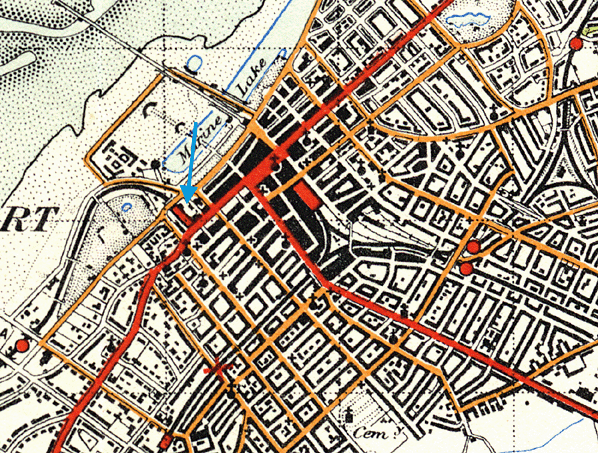
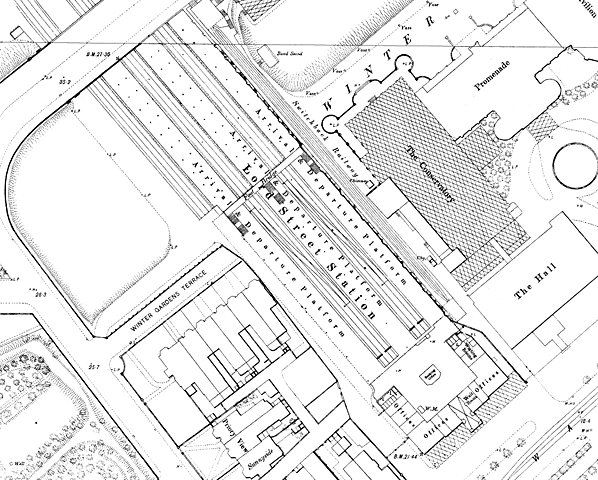
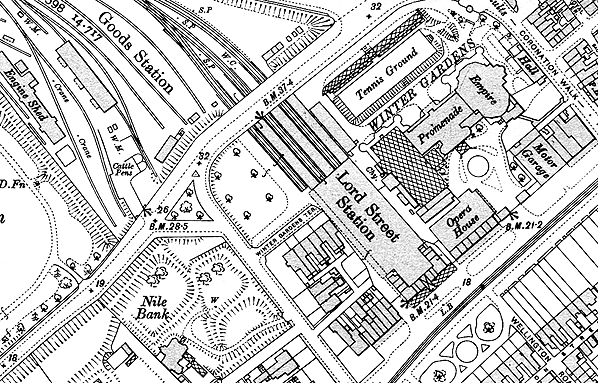
5.jpg) A view looking north-west along Southport Lord Street's platform 3 in 1910. The footbridge that served little purpose at a terminus station is seen at the far end of the train-shed.
A view looking north-west along Southport Lord Street's platform 3 in 1910. The footbridge that served little purpose at a terminus station is seen at the far end of the train-shed.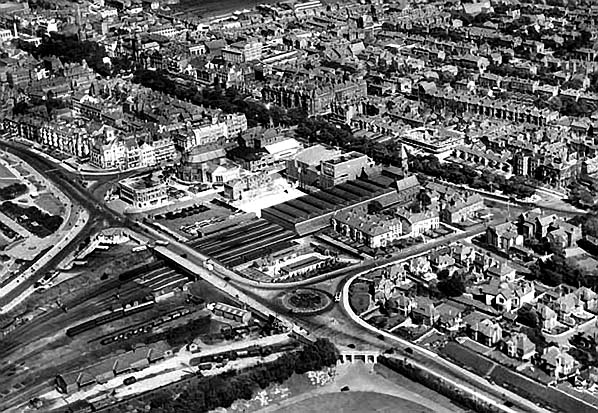
lord_street.jpg)
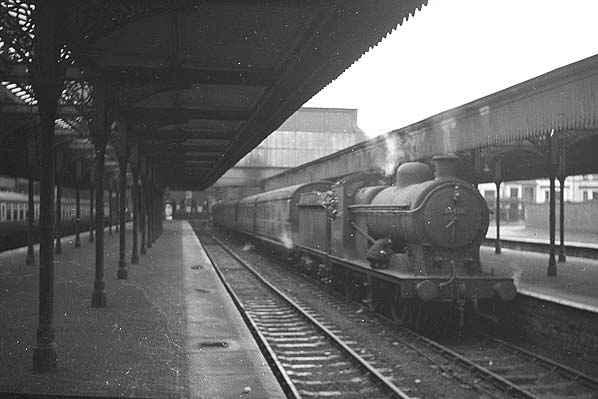
lord_street.jpg)
lord_street.jpg)
.jpg)
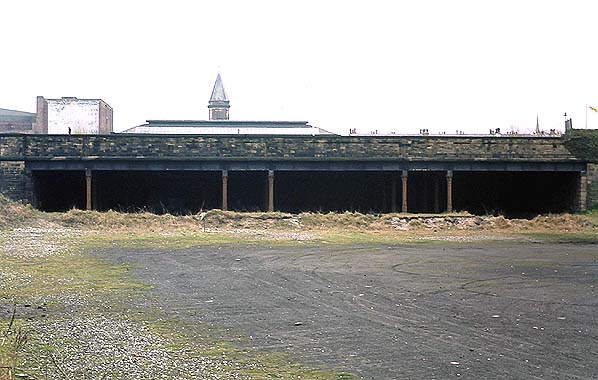
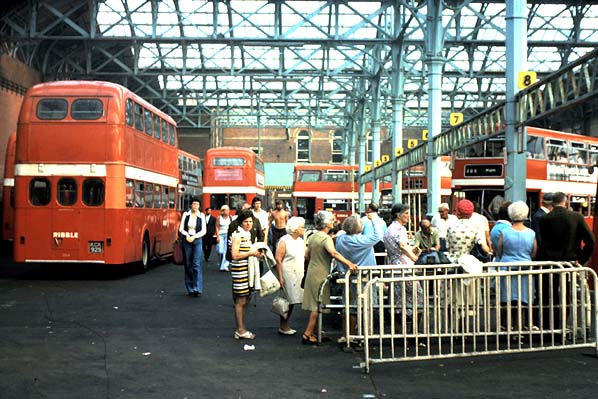
.jpg)
 The SCLER opened on 1 September 1884. The company’s Southport terminus was located towards the south end of Lord Street on the south-west side. Lord Street was the main street of Southport, a spacious boulevard developed with shops fronted by elegant glass verandahs, theatres and hotels. Napoleon III lived in the town for five years until 1851. After he returned to France to become Emperor, much of the centre of Paris was laid out with wide tree-lined boulevards – possibly inspired by Southport! The SCLER had a convenient location for their terminus close to the centre of the town.
The SCLER opened on 1 September 1884. The company’s Southport terminus was located towards the south end of Lord Street on the south-west side. Lord Street was the main street of Southport, a spacious boulevard developed with shops fronted by elegant glass verandahs, theatres and hotels. Napoleon III lived in the town for five years until 1851. After he returned to France to become Emperor, much of the centre of Paris was laid out with wide tree-lined boulevards – possibly inspired by Southport! The SCLER had a convenient location for their terminus close to the centre of the town. Unusually for a terminus the station had a footbridge which linked the four platforms at the western end of the trainshed roof. A cab road was located on the south side of the station; it was protected from the elements by an iron and glass roof.
Unusually for a terminus the station had a footbridge which linked the four platforms at the western end of the trainshed roof. A cab road was located on the south side of the station; it was protected from the elements by an iron and glass roof.  In the early years of the twentieth century the CLC was promoting its services to Southport Lord Street to holidaymakers and day trippers. In the summer months many excursion trains were run and the station was a busy place. It was less so in the winter period as the SCLER passed through an area of very little population.
In the early years of the twentieth century the CLC was promoting its services to Southport Lord Street to holidaymakers and day trippers. In the summer months many excursion trains were run and the station was a busy place. It was less so in the winter period as the SCLER passed through an area of very little population.  The 1920s and 1930s were the golden years for British seaside towns such as Southport. Hundreds of thousands of holidaymakers and day trippers visited. Southport Lord Street handled its fair share of the traffic. The North Liverpool Extension Line passed through the expanding outer suburbs of Liverpool and the opening of new stations at Clubmoor in 1927 and Warbreck in 1929 gave their inhabitants a fast and direct link to Southport.
The 1920s and 1930s were the golden years for British seaside towns such as Southport. Hundreds of thousands of holidaymakers and day trippers visited. Southport Lord Street handled its fair share of the traffic. The North Liverpool Extension Line passed through the expanding outer suburbs of Liverpool and the opening of new stations at Clubmoor in 1927 and Warbreck in 1929 gave their inhabitants a fast and direct link to Southport. Despite the recent investment at Lord Street British Railways decided to close it to passenger services with effect from 7 January 1952. The intermediate stations between Southport Lord Street and Aintree also closed. Goods services continued to serve Lord Street until 7 July 1952 after which the station closed completely. The signal box - just three years old - closed on the same day as did the line between Southport and Altcar & Hillhouse. It was dismantled and transferred to Ribble sidings Preston (opening in June 1953). The original signal box which had closed in 1949 was still standing in 1955. After closure the track remained in situ until 1957 when it was lifted back to Altcar & Hillhouse.
Despite the recent investment at Lord Street British Railways decided to close it to passenger services with effect from 7 January 1952. The intermediate stations between Southport Lord Street and Aintree also closed. Goods services continued to serve Lord Street until 7 July 1952 after which the station closed completely. The signal box - just three years old - closed on the same day as did the line between Southport and Altcar & Hillhouse. It was dismantled and transferred to Ribble sidings Preston (opening in June 1953). The original signal box which had closed in 1949 was still standing in 1955. After closure the track remained in situ until 1957 when it was lifted back to Altcar & Hillhouse.


 Home Page
Home Page